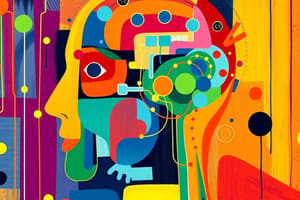Podcast
Questions and Answers
Which of the following is NOT a characteristic of Machine Learning (ML)?
Which of the following is NOT a characteristic of Machine Learning (ML)?
- Decision-making with minimal human intervention.
- Systems learn from data.
- Explicit programming for all scenarios. (correct)
- Identification of patterns in data.
Which of the following tasks is most closely associated with Natural Language Processing (NLP)?
Which of the following tasks is most closely associated with Natural Language Processing (NLP)?
- Identifying objects in an image.
- Determining the emotional tone of a text. (correct)
- Controlling the movement of a robot.
- Predicting stock market trends.
In the context of Machine Learning, what is the primary difference between supervised and unsupervised learning?
In the context of Machine Learning, what is the primary difference between supervised and unsupervised learning?
- Supervised learning requires labeled data for training, while unsupervised learning does not. (correct)
- Supervised learning uses numerical data, while unsupervised learning uses categorical data.
- Supervised learning algorithms are simpler than unsupervised learning algorithms.
- Supervised learning is used for classification tasks, while unsupervised learning is used for regression tasks.
Which of the following techniques is most directly associated with enabling computers to understand the spatial relationships in images?
Which of the following techniques is most directly associated with enabling computers to understand the spatial relationships in images?
Consider a scenario where a cutting-edge AI startup aims to develop a system capable of generating highly personalized marketing content that dynamically adapts to individual user preferences and real-time contextual cues. This system must seamlessly integrate natural language generation, sentiment analysis, and user behavior prediction. Which architectural approach would most effectively harmonize these diverse functionalities while ensuring scalability and minimal latency?
Consider a scenario where a cutting-edge AI startup aims to develop a system capable of generating highly personalized marketing content that dynamically adapts to individual user preferences and real-time contextual cues. This system must seamlessly integrate natural language generation, sentiment analysis, and user behavior prediction. Which architectural approach would most effectively harmonize these diverse functionalities while ensuring scalability and minimal latency?
Flashcards
Machine Learning (ML)
Machine Learning (ML)
A subset of AI focused on enabling systems to learn from data without explicit programming, allowing them to improve from experience. It builds a model from training data to make predictions or decisions.
Supervised Learning
Supervised Learning
Uses labeled data to train a model to map inputs to outputs, commonly used for classification and regression tasks.
Unsupervised Learning
Unsupervised Learning
Uses unlabeled data to discover patterns and structures, involving techniques like clustering and dimensionality reduction.
Natural Language Processing (NLP)
Natural Language Processing (NLP)
Signup and view all the flashcards
Computer Vision
Computer Vision
Signup and view all the flashcards
Study Notes
- Artificial Intelligence (AI) broadly refers to the capability of a machine to imitate intelligent human behavior.
- AI aims to create systems that can perform tasks usually requiring human intelligence
- AI encompasses a wide range of subfields, including machine learning, deep learning, natural language processing, computer vision, and robotics.
Machine Learning
- Machine Learning (ML) is a subset of AI focused on enabling systems to learn from data without explicit programming
- ML algorithms can automatically learn and improve from experience
- ML algorithms build a model based on sample data, known as "training data", in order to make predictions or decisions without being explicitly programmed to do so
- Core idea: systems learn from data, identify patterns, and make decisions with minimal human intervention
ML Types
- Supervised learning: Uses labeled data to train a model to map inputs to outputs
- Examples include classification and regression
- Unsupervised learning: Uses unlabeled data to discover patterns and structures
- Examples include clustering and dimensionality reduction
- Reinforcement learning: An agent learns to make decisions by interacting with an environment to maximize a reward signal
- Used in robotics, game playing, and control systems
ML Algorithms
- Linear Regression: Models the relationship between variables with a linear equation
- Logistic Regression: Predicts the probability of a binary outcome
- Support Vector Machines (SVM): Finds the optimal hyperplane to separate data into classes
- Decision Trees: Uses a tree-like structure to make decisions based on features
- Random Forest: Ensemble of decision trees, improving accuracy and reducing overfitting
- Neural Networks: Modeled after the human brain, used for complex tasks like image and speech recognition
- K-Means Clustering: Partitions data into k clusters based on distance to centroids
Natural Language Processing
- Natural Language Processing (NLP) focuses on enabling computers to understand, interpret, and generate human language
- NLP combines computational linguistics with machine learning models
- Enables machines to process and understand spoken and written language
NLP Tasks
- Text classification: Assigning categories to text, such as spam detection or sentiment analysis
- Sentiment analysis: Determining the emotional tone of text
- Machine Translation: Translating text from one language to another
- Named Entity Recognition (NER): Identifying and classifying named entities in text, e.g., persons, organizations, locations
- Text summarization: Creating concise summaries of longer texts
- Question answering: Answering questions posed in natural language
- Language generation: Generating human-like text
NLP Techniques
- Tokenization: Splitting text into individual words or tokens
- Part-of-speech tagging: Assigning grammatical tags to words (e.g., noun, verb, adjective)
- Parsing: Analyzing the grammatical structure of sentences
- Word embeddings: Representing words as vectors in a high-dimensional space, capturing semantic relationships
- Common techniques include Word2Vec and GloVe
- Recurrent Neural Networks (RNNs): Processing sequential data like text
- Transformers: A type of neural network architecture that excels at NLP tasks due to its ability to handle long-range dependencies
- Models like BERT, GPT, and T5 are based on the transformer architecture
Computer Vision
- Computer Vision focuses on enabling computers to "see" and interpret images and videos.
- Computer Vision enable machines to extract, analyze, and understand information from visual data.
- It aims to give computers the ability to process and understand images in a way that is similar to human vision.
Computer Vision Tasks
- Image classification: Identifying the content of an image
- Object detection: Locating and identifying objects within an image
- Image segmentation: Partitioning an image into multiple segments or regions
- Facial recognition: Identifying or verifying individuals from images of their faces
- Image generation: Creating new images from text descriptions or other inputs
Computer Vision Techniques
- Convolutional Neural Networks (CNNs): A type of neural network designed for processing images
- CNNs use convolutional layers to automatically learn spatial hierarchies of features
- Transfer learning: Using pre-trained models on large datasets (e.g., ImageNet) and fine-tuning them for specific tasks
- Data augmentation: Creating new training samples by applying transformations to existing images (e.g., rotations, crops, flips)
- Feature extraction: Extracting relevant features from images for further analysis
- Techniques include edge detection, corner detection, and texture analysis
- Object tracking: Following the movement of objects in video streams
Studying That Suits You
Use AI to generate personalized quizzes and flashcards to suit your learning preferences.




